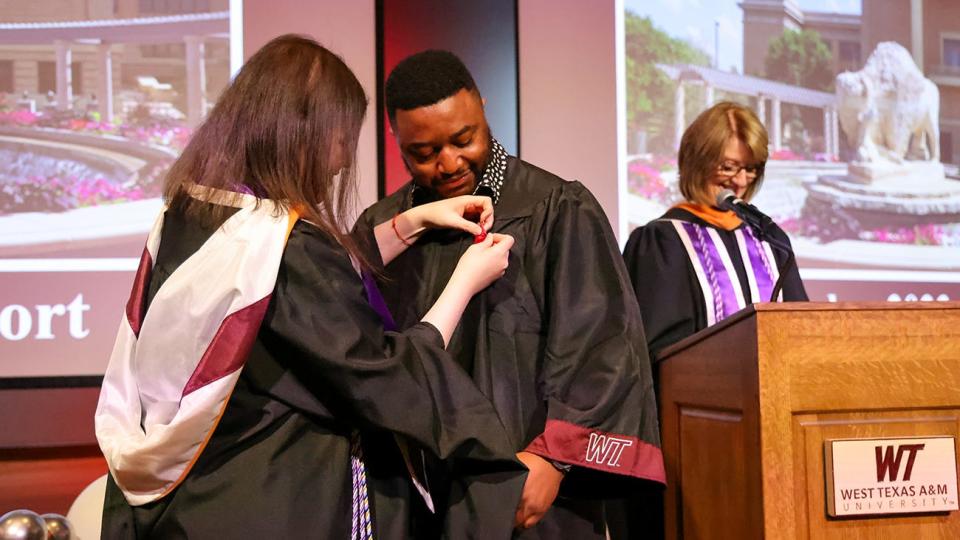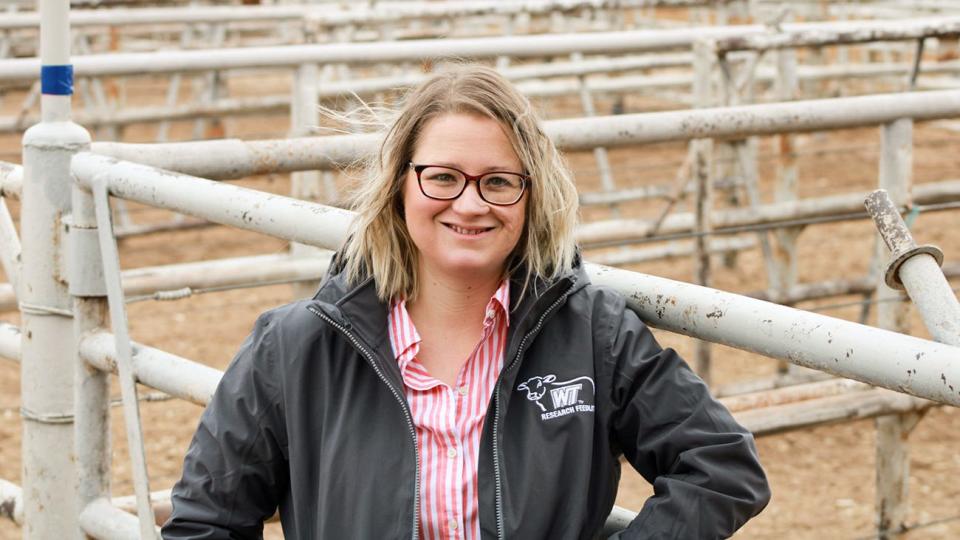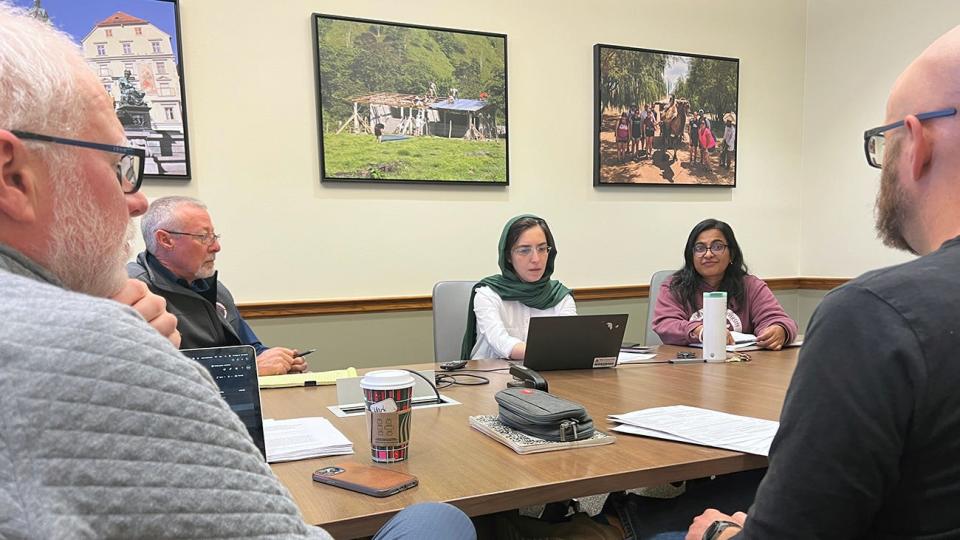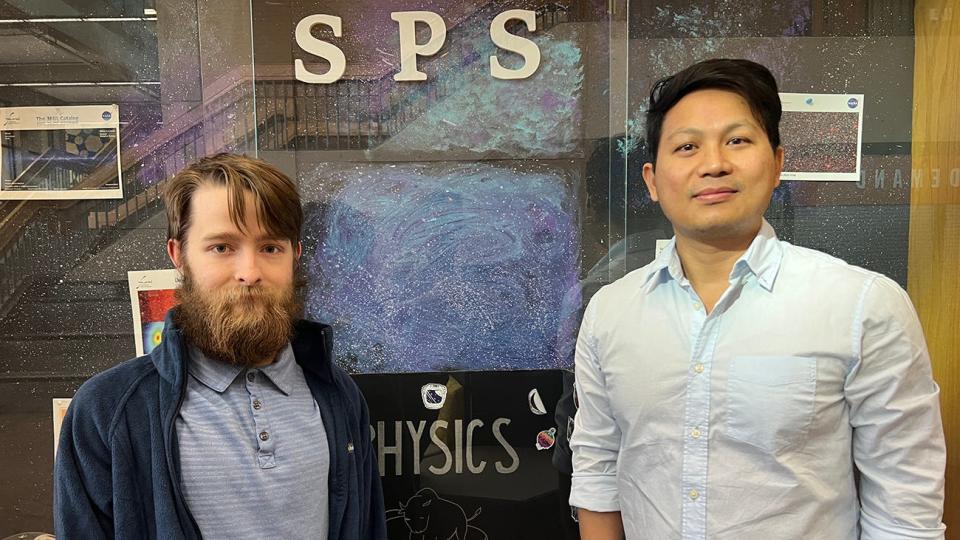News from West Texas A&M University: Nursing pinning ceremony, research grants
December WT Nursing graduates honored at pinning ceremony
CANYON, Texas — More than 40 graduates from West Texas A&M University’s nursing program were honored at a pre-commencement observance.
The WT Department of Nursing’s annual pinning ceremony — held at 11 a.m. Dec. 8 in Legacy Hall inside the Jack B. Kelley Student Center on WT’s Canyon campus — recognized 61 students who graduated Dec. 9.
Pinning ceremonies are an opportunity to recognize the students’ hard work and dedication in their clinicals and in classwork, marking the transition from student to nurse, said Dr. Collette Loftin, interim head of WT’s Department of Nursing and the Nancy and John Kritser Professor of Nursing. “Our pin is especially striking and is work with pride by all those who earn it,” Loftin said. “When we pin our graduating seniors, we are warmly welcoming them into the profession of nursing and the ever-growing family of WT nurses.”

Of the 41 graduates, 32 will work in Amarillo, while others have accepted jobs in Lubbock or elsewhere outside the Panhandle.
December 2023 graduates in the bachelor of science in nursing program who were pinned are (with hometowns): Sariah Breshun Battle, Lubbock; Citlali Botello, Dumas; Raylee Kathryn Brown, Nocona; Adam Caswell, Amarillo; McKenna Lynn Cavalier, Canadian; Raeann Elyssa Davis, Rockwall; Jentre Dawn Dollar, Amarillo; Georgina Montserrath Flores, Canadian; Jacquelyne Gallegos, Dumas; Hannah McKenzie Gibson, Amarillo; Savannah Grace Gibson, Canyon; Jacquelyn Hatley, Amarillo; Dakota Ethan Hernandez, Amarillo; Maggie E. Hernandez, Pampa; Klaire McKinleigh Jeffreys, Bushland; Katherine Annelise Jewell, Lubbock; Alejandra Maria Jurado, Albuquerque, New Mexico; Sarah Michelle King, Amarillo; Haley Marie Krauser, Post; Trista Jade Lawson, Bowie; Aubrey Madeleine Lewis, Amarillo; Gracie Elizabeth Liles, Amarillo; Wendy J. Lizardo, Amarillo; Chaney Cree McCuistion, Fowler, Colorado; Kitawny Shay Molina, Amarillo; Katelynn Ann Noel, Canyon; Kiven Peter Nsameluh, Amarillo; Valeria Pacheco Ramirez, Canyon; Shannyn Leighanne Payne, Odessa; Iliana Pecina, Amarillo; Annahi Ruiz, Stratford; Lia Yun E. Schneider, Amarillo; Sierra Autumn Schomp, Borger; Lauren Kate Segura, Dana Point, California; Cheyann Dreu Shadden, Abernathy; Kyra Anne Stevens, Lubbock; Jose Tellez, Dodson; Peyton Reese Watson, Tulia; Alyssa Abree Williams, Amarillo; Audree Brooke Wilson, Sunray; and Ethan Carter Zimmerman, Lubbock.

WT ag professor wins grant to continue research into critical issue in feedlot cattle
CANYON — A West Texas A&M University faculty member recently won a $300,000 grant to study ways to prevent liver abscesses in feedlot cattle.
Dr. Kendall Samuelson, associate professor of animal science in the Department of Agricultural Sciences in WT’s Paul Engler College of Agriculture and Natural Sciences, was awarded $300,000 from the International Consortium for Antimicrobial Stewardship in Agriculture, which will be matched by WT.
“Liver abscesses are a major concern for commercial beef producers and processors, but we still have a lot to learn about them,” Samuelson said. “Expanding our understanding of why and when they develop will help us improve liver abscess prevention strategies and promote judicious use of antibiotics.”
Liver abscesses often occur in feedlot cattle because they are fed a high-energy, low-roughage diet in order to reach the desired quality grades weight prior to slaughter.
The ICASA grant will support Samuelson’s efforts to evaluate the differences in liver abscess development in feedlot cattle raised in conventional beef versus dairy management systems. In 2022, Samuelson won a separate $266,748 grant to investigate such liver abscesses and their relationship to acids in the rumen, the first chamber of a cow’s four-chamber stomach.
“As crossbreeding beef and dairy cattle becomes more common in commercial dairies, the number of these animals entering the fed beef supply is increasing,” Samuelson said. “Management practices before feedlot arrival are drastically different for beef than dairy calves, so it is important to understand the influence that early life management of the animal has on the prevalence of liver abscesses.”

WT researcher wins USDA grant to encourage women, minorities in STEM fields
CANYON — A West Texas A&M University professor recently won a U.S. Department of Agriculture grant to support women and minorities in STEM fields.
The project — led by Dr. Mona Ozmaeian, assistant professor of mechanical engineering in WT’s College of Engineering — was one of 10 that won a total of $2 million in USDA National Institute of Food and Agriculture grants. Ozmaeian’s project is an online, interactive toolkit tailored to teach students in kindergarten through 12th grades about the hydrological cycle.
“This intricate journey involves the vaporization of water from the Earth, its return through rainfall, and the fascinating processes within soil and plants,” Ozmaeian said. “Our aim was to show students why delving into science is essential for grasping these phenomena.”
It’s a project particularly suited to this region, she noted. “The Panhandle is one of the most agriculturally productive regions in the U.S., producing onethird of the nation’s beef, and annually contributing $5.7 billion in agricultural receipts (crops and livestock,” Ozmaeian’s project summary says. “The drought-prone and semiarid region has been plagued with water shortages and diminishing groundwater in recent decades; thus, water is a critical regional issue.”
Once completed, the online tool will be offered to K-12 teachers in rural school systems and to county extension agents working with 4H and FFA clubs, Ozmaeian said.
Also working on the project are Dr. Swastika Bithi, assistant professor of engineering; Dr. Mark Garrison, professor of education and Killgore Research Center doctoral research faculty; Dr. Nathan Howell, the Bell Professor of Engineering; and Dr. David Parker, associate professor and extension specialist in water engineering.

WT students, professor publish research into new possibilities in faster electronics
CANYON — Student researchers from West Texas A&M University recently published a study into a new metal compound that could aid in the search for more efficient electronics.
Cole Phillips, a senior physics major from Amarillo, and Thinh (John) Nguyen, a WT graduate now pursuing a Ph.D. in chemistry at Texas A&M University, were among the research team examining a vanadium-based compound that could have a profound impact on the development of quantum computers.

The students — along with Dr. Keshav Shrestha, assistant professor of physics in WT’s Paul Engler College of Agriculture and Natural Sciences, and other team members — published "Electronic Properties of Kagome Metal ScV6Sn6 Using High-Field Torque Magnetometry” on Dec. 7 in Physical Review B, the world’s largest dedicated physics journal.
Shrestha and several of his students have conducted experiments at the National High Magnetic Field Laboratory in Tallahassee, Florida, on Kagome lattices in newly discovered metal compounds, similar to lattice patterns found in natural minerals. The unusual geometry of these Kagome materials, whose atomic structures resemble woven Japanese baskets, have topological properties that can increase the speed of electrical transmissions.
Ultimately, the unique properties of these Kagome materials could be used in the creation of quantum computers, which are thousands of times faster than current models. “It’s super exciting to be published, and it couldn’t come at a better time,” Phillips said. “I’m applying for graduate schools this month."
This article originally appeared on Amarillo Globe-News: West Texas A&M University announces nursing pinning ceremony, grants

